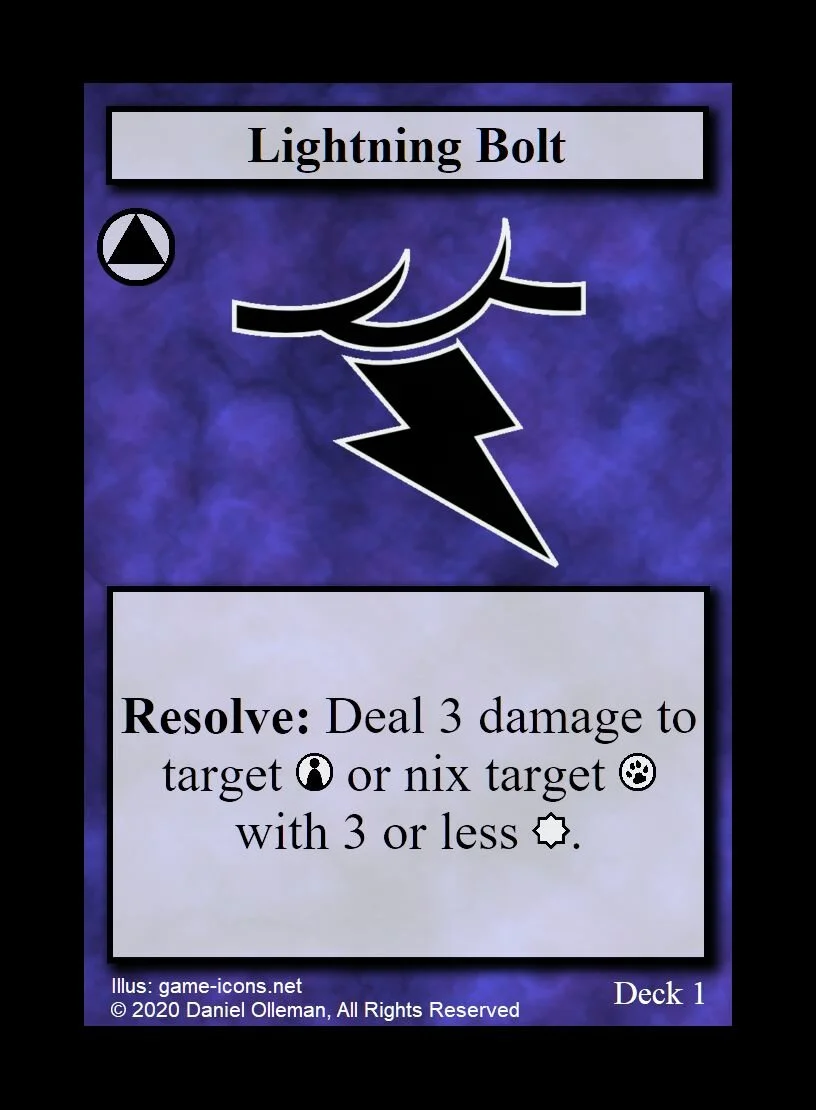Rules
Contents:
2 x 30 card decks
Stack cards numbering 1-8
First Player card
Printable Images below
Overview and Objective:
In Chaos Casters, you take on the role of a player seeking to Nix their rival. The objective of the game is to be the last player in the game. A player loses the game when they cannot take all the damage being dealt to them.
The Board:
The game is played using a number of different areas. Both players share a Stack in the center of the table. In addition, each player has a: Deck, Pit, and Hand.
Setup:
Each player chooses a deck of 30 cards to play with (recommended decks labeled as “Deck 1” and “Deck 2” in lower right of cards). Make a Stack between the players with 8 positions numbered from 1-8 with 1 being the bottom and 8 being the top. Randomly choose who will go first and give them the first player card. Each player then shuffles their deck and places it face down in front of them. Each player also draws a hand of 6 cards, looks at it, chooses any number of cards from their hand to put on the bottom of their deck in any order, and then draws cards again until their hand has 6 cards.
Card types and parts of a card:
There are two types of cards in a player’s deck. They are: Actions, and Allies. Each card’s type is represented by a symbol located near the upper left corner of the card. The symbol for Actions is a triangle while the Allies symbol is a paw print.
Actions cards have 4 parts while Allies cards have 5 parts. The parts of an action card are: name, type symbol, artistic graphic, and effect text. The name on Actions can be found at the top of the card. The card’s type is found just under the name on the left. The artistic graphic can be found immediately under the name. The effect text can be found under the graphic. In addition, Allies have a strength value located immediately under their type symbol.
Game Rounds:
This game is played over a series of rounds. Each round has 3 phases which occur in the following order:
Play Phase
Resolve Phase
End of Round
Play Phase:
During this phase, players alternate taking turns doing 1 of 2 different actions. The actions a player may take are:
Play a card
Refill action
The player with the “First Player card” takes the first turn and must play a card if they have any in their hand. When: all line positions are occupied, a quick card has been played, or both players take refill actions consecutively; proceed to the Resolve Phase.
Playing a Card:
Cards may be played as a player’s action from their hand in the play phase or by another card’s effect. When a card is played during the play phase, put it on the closest open position to the bottom of the stack (position 1).
Refill Action:
When a player takes a Refill Action during the play phase, they may put any number of cards in their hand on the bottom of their deck in any order. They then draw cards from the top of their deck until they have 6 cards in hand.
Resolve Phase:
During the Resolve Phase, cards are resolved starting with the card at the top of the stack (the one closest to the 8 Position). Then, continue to resolve cards sequentially moving towards the bottom of the stack. After the bottom card has been resolved, proceed to the End of Round.
Resolving a Card:
When resolving a card, the card’s owner does the following in order:
Perform any Resolve effects on the card. These effects are signified by the preceding text “Resolve:”.
An Ally card may choose and attack an enemy player, or Ally. An Ally may only be attacked if it is on the stack. (See Attacks)
Note: some cards have Once Per Round written on them. Each player may only resolve a card’s effect with Once Per Round on it once that resolve phase. If there are two friendly copies of that card on the stack or the same copy is moved such that it would resolve twice, perform any attacks if applicable and then proceed to resolving the next card.
Other Effects:
If an effect is not preceded by “Resolve:” text, perform that effect whenever the card specifies to perform it before continuing the game. If the card does not specify when the effect should be performed, the effect is considered continuous and is performed at all times.
Nixing Cards and Pits:
When a card is nixed by: an attack, card effect, or player damage; it is placed into its owner’s pit face up. Cards in a pit may be looked at by any player at any time.
Attacks:
When an Ally attacks an opponent’s Ally, nix the Ally with the lowest strength. If the two Allies have the same strength, nix both Allies. When an Ally Attacks a Player, it deals damage to the player equal to its strength (See Damage).
Damage:
When a player takes damage, they must nix cards from the bottom of their deck equal to the amount of damage being dealt. If a player cannot take all of the damage they are dealt, that player loses the game.
End of Round:
After the last card has been resolved on the stack, all remaining cards on the stack are put on the bottom of their owners’ decks. Each player with more than 6 cards in hand must put cards from their hand onto the bottom of their deck until they only have 6 cards in hand. The player with the “First Player card” passes the card off to the next player. The round is over and play proceeds to the play phase of the next round.
End of game:
If a player cannot take all their damage, they lose the game. If only one player has not lost the game, they are declared the winner.
Appendix/Misc Rules:
Stack:
The Stack is a set of cards called positions between the players numbered from 1-8 with 1 being the bottom and 8 being the top. During the play phase players may play cards to the stack on the first available position closest to the bottom. If there are 8 cards on the stack, the game proceeds to the resolve phase. During the resolve phase, cards are resolved from the top of the stack moving towards the bottom of the stack. In addition, cards may be added: in-front of, after, or between the original 8 stack positions during the resolve phase.
Deck:
A deck area where a shuffled deck of cards is placed face down. Each players starting deck consists of 30 cards. A starting deck can contain up to 2 copies of the same card in it.
Pit:
A pit is where nixed cards are placed face up (see Nixing Cards). Cards in a pit are public knowledge for both players.
Hand:
A hand is a private area where only the hand's owner can see the cards in it. During the play phase, players may play cards from their hand onto the stack.
Targets:
Some cards will require a target when they resolve. If a card asks for a target, choose an appropriate card to be the target when it resolves and perform the effect on that card. Targets only need to be declared upon resolution of the card and not when it is played initially. If no appropriate target exists, the effect does not resolve.











